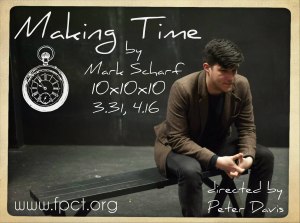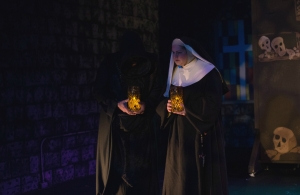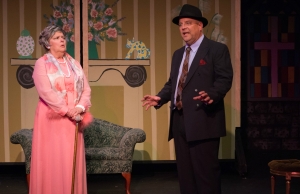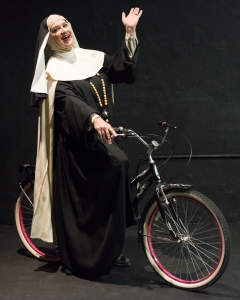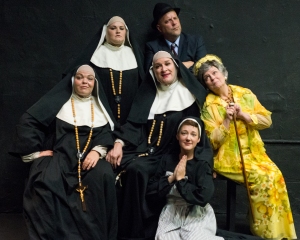By Jason Crawford Samios-Uy
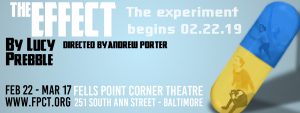
Running Time: Approx. 2 hours with one 15-minute intermission
When one thinks about drug trials, rarely does theatre come up in the same thought. However, from my experience, anything, any topic, and any story can become theatre and, in this instance, the topic happens to be drug trials. In Fells Point Corner Theatre‘s latest offering, The Effect by Lucy Prebble, Directed by Andrew Porter, presents us with a sneak peek of what might happen in a drug trial for a nondescript drug that is going through human testing.

Nate Krimmel and Meghan Stanton. Credit: Trent Haines-Hopper/THsquared Photography
From what I could gather, in a nutshell, The Effect concerns itself with two volunteers, Tristan and Connie, and two doctors, Dr. Lorna James and Dr. Toby Sealey. They are all in the process of testing a new drug and all the while, a new relationship develops between the volunteers and an old relationship is reminisced between the doctors. Ethics are questioned and results are recorded but those results may not be what was intended.
I’m usually quite fond of the shows produced by Fells Point Corner Theatre but this particular production did not pique my interest in the least. I tried to be interested in the story and invested in the characters, but, alas, I was not. The production value and performance is superb, don’t get me wrong, but I’m not sold on the script and characters. Also, it seems the whole drug trial story line is simply a backdrop for the real story, which is the complex relationships between the characters. Some of the trial process is presented but most of the action revolves around the relationships. Maybe that’s the point?
It’s worth mentioning a definite highlight of this production which is the impressive and superlative Set Design by Bruce Kapplin. This design is clean and modern and fits this production perfectly. Two levels and perfectly symmetrical, Kapplin has captured the sanitized look of a hospital with a couple of levels and a few set pieces and he should be applauded for his impeccable design.
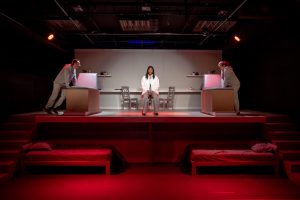
(l-r) Nate Krimmel, Mia Robinson, and Meghan Stanton. Credit: Trent Haines-Hopper/THsquared Photography
I must say, though, Director Andrew Porter certainly has a deep comprehension of this material and he has given us a polished, well put-together production with precise staging (though, be prepared for loud, thumping dance/electronic music shaking the entire theatre), and his vision is clear. Porter can only work with what he has, text-wise, and he does a splendid job in presenting the piece.
Most of the performances are spot on and Megan Stanton is a standout, taking on the role of Connie, one of the volunteers, gives a brilliant performance. Her delivery is natural and smooth making her character believable. She seems to have a good grasp of her character’s conflict and presents her beautifully. Nate Krimmel, who takes on the role of Tristan, a volunteer with experience with taking part in these types of trials, seems to understand his character, but also seems to be trying a little too hard to portray his character’s quirks. He presents Tristan a little over the top at times that takes away from the naturality. Both work well together and the chemistry is there… but I don’t buy it lock, stock, and barrel. This probably is not so much a comment on Stanton and Krimmel’s performances, but they fact I just didn’t connect 100% with the characters as written. Regardless of my feelings or connection (or lack thereof) of these characters, Stanton and Krimmel give confident and commendable performances.

Nate Krimmel and Megan Stanton. Credit: Trent Haines-Hopper/THsquared Photography
Another highlight of this piece is Mia Robinson, who tackles the role of Dr. Lorna James, who’s heading up the trial but is a licensed psychologist who seems to have needed a job, and this is in the medical field, after all. Robinson, like Stanton, has a natural flow to her performance that makes her character more believable. She makes good choices with her character and she’s one that I could find myself just the tiniest bit invested in, which is a good thing. Her delivery is authentic and she’s comfortable on stage which makes for a strong, assured performance. Her counterpart, Dr. Toby Sealey, portrayed by Gareth Kelley, is a little stiffer, as apparently written, but Kelley’s performance is a bit stiff as well. He seems scripted and, at times, uncomfortable in the role. He doesn’t completely falter and he seems to have a good comprehension of his character, but there’s no “oomph” behind his portrayal. The chemistry between the two is nil, at most, but they do get the idea across.
Again, my major beef is with the story and material itself, the performers did, for the most part, admirable jobs and, like I stated with Director Andrew Porter, you work with what you got and this ensemble’s presentation is commendable.
Final thought… The Effect, is a well put-together and polished piece and (most of) the performances are on point but it just couldn’t keep my interest. Staging was great and the message of ethics within drug trial testing is apparent but, it’s not something I think an entire show can be written around. So, I suppose it’s the subject matter itself is what didn’t capture my attention. Medical dramas are tricky and if you’re not into it, there’s not much that can happen to bring you in. Production-wise, this production is top notch from the Set Design to staging to performance and it’s definitely worth checking out!
This is what I thought of this production of The Effect at Fells Point Corner Theatre.… what do you think?
The Effect will play through March 17 at Fells Point Corner Theatre, 251 S Ann Street, Baltimore, MD 21231. For tickets, call 410-276-7837 or purchase them online.
Email us at backstagebaltimore@gmail.com
Like Backstage Baltimore on Facebook, and follow us on Twitter and Instagram!



